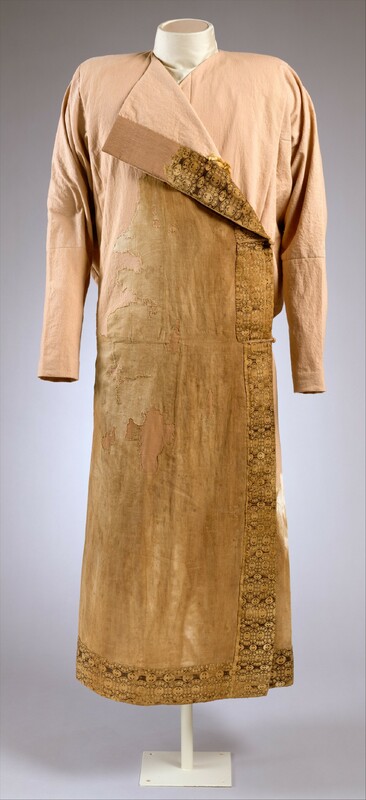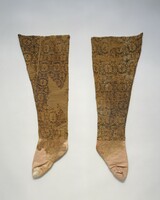Caftan and leggings
Date:
Eighth or ninth century
Location or Findspot (Modern-Day Country):
Russia
Dimensions:
191.8 × 144.8 × 111.8 cm (caftan); 80 cm (leggings)
Description:
A pair of leggings and a caftan are among numerous items found in an eighth- or ninth-century necropolis at Moščevaja Balka in the northern Caucasus (east of the Black Sea, in southwestern Russia). Walled graves (568 of them) and dry ground helped mummify the bodies and preserved a large quantity of materials, not just clothing—both full-size and miniature pieces, the latter presumably for use in the afterlife since no dolls were found—but also weapons, musical instruments, pen cases, jewelry, and other objects used by people of the Circassian and Alan tribes under the rule of the Khazars, a Turkic people whose rulers apparently adopted Judaism over the course of the eighth and ninth centuries.
The man's double-breasted caftan is made of pieces of undyed linen, originally lined with fur, with patterned silk trim along the edges; its lapels closed with three linen buttons and loops. Tight over the chest and flaring from the waist, the caftan, 142 centimeters high, reached the calves of a tall man (approx. 1.8 m). The leggings (81 cm long) are made of patterned silk, now faded, attached to linen feet; originally they were held up by strings attached to a belt. These are traditional garments, used across the Iranian and Central Asian steppes, especially in the Turkic realm.
Chinese, Central Asian, and Mediterranean silks reached this remote region and were found in the necropolis. Commercial tolls are thought to have been paid in silk, which was then cut up and used on garments—even the humblest article of clothing has some silk trim. Silk was also manufactured locally, and this lower-quality fabric was used on the caftan and leggings. One indication of lower quality is the dyes, which have faded; another is that these pieces employ only a few simplified patterns, including pearl-edged roundels, stylized boars' heads, and rosettes. The pieces that make up the caftan were used previously, but whether the material was recycled for talismanic motives (because the previous user was an important person) or for practical ones (because handmade work was available and valued) is not clear. In terms of status and identity, the silk-trimmed caftan and leggings were made for a male horseman who, despite some pretensions, did not belong to the very highest social echelon but still sought to clothe himself in decorated finery.
The man's double-breasted caftan is made of pieces of undyed linen, originally lined with fur, with patterned silk trim along the edges; its lapels closed with three linen buttons and loops. Tight over the chest and flaring from the waist, the caftan, 142 centimeters high, reached the calves of a tall man (approx. 1.8 m). The leggings (81 cm long) are made of patterned silk, now faded, attached to linen feet; originally they were held up by strings attached to a belt. These are traditional garments, used across the Iranian and Central Asian steppes, especially in the Turkic realm.
Chinese, Central Asian, and Mediterranean silks reached this remote region and were found in the necropolis. Commercial tolls are thought to have been paid in silk, which was then cut up and used on garments—even the humblest article of clothing has some silk trim. Silk was also manufactured locally, and this lower-quality fabric was used on the caftan and leggings. One indication of lower quality is the dyes, which have faded; another is that these pieces employ only a few simplified patterns, including pearl-edged roundels, stylized boars' heads, and rosettes. The pieces that make up the caftan were used previously, but whether the material was recycled for talismanic motives (because the previous user was an important person) or for practical ones (because handmade work was available and valued) is not clear. In terms of status and identity, the silk-trimmed caftan and leggings were made for a male horseman who, despite some pretensions, did not belong to the very highest social echelon but still sought to clothe himself in decorated finery.
Relevant Textbook Chapter(s):
4,
5


